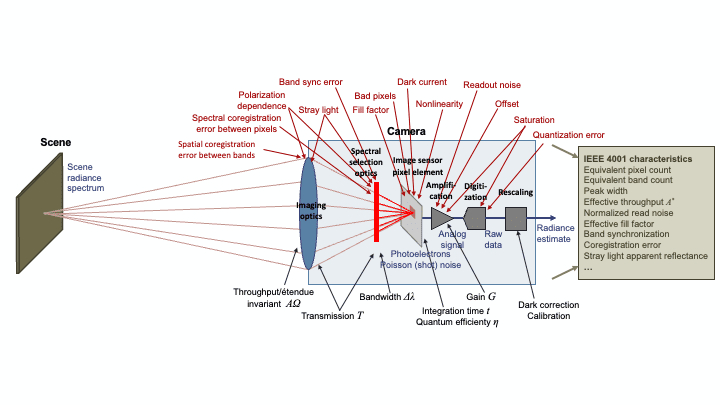Setting a new standard for camera characterization
The IEEE 4001™ standard defines a set of characteristics covering all aspects of camera performance. The standard also defines camera-related metadata which can improve information extraction from images. Its formal scope covers the most common types of hyperspectral cameras, for which specifications are directly comparable. With some adaptation, IEEE 4001 can be applied for specification of other types of cameras as well.
IEEE 4001 offers camera users and buyers drastically improved insight into camera performance, compared to earlier practices. An IEEE 4001 compliant camera specification provides for predictive modelling of application performance. There are many ways in which a camera can be a limitation, or cause disappointment, in a given application. A camera specification according to IEEE 4001 will make buyers better informed, and help users understand how the camera affects their image data.
Addressing a long-standing community need
Camera specifications have traditionally been inadequate for prediction of actual application performance. Also, metadata provided with images often do not give complete information about the imprint left by the camera on the image data. There has been no widely agreed way to specify all major aspects of performance for a complete camera including optics. This gap has persisted even in the highly technical field of hyperspectral imaging, where the community has recognized that there is a need to improve the way cameras are specified.
A working group of about 100 people, representing a cross-section of the hyperspectral community, has worked to develop a set of camera characteristics and image metadata that give an essentially complete description of the performance of a hyperspectral camera, with potential for wider applicability. This effort has led to the IEEE 4001 standard, which has been approved in 2025.
Formal scope and extended usability.
Formally, IEEE 4001 “Standard for Characterization of Hyperspectral Imaging Devices – Ultraviolet through Shortwave Infrared” applies to hyperspectral cameras operating in the spectral range from 250 to 2500 nm wavelength, mostly used for imaging of reflected light, and with a spectral sampling interval not exceeding 1/30 of the spectral range.
IEEE 4001 applies to cameras based on the common “pushbroom” imaging spectrometer architecture, and also snapshot “array imaging” cameras as well as tunable filter cameras and scanned point spectrometers. Camera specifications compliant to IEEE 4001 can be directly compared between these different camera types.
Beyond the formal scope, the IEEE 4001 standard can also be used to guide specification of other camera types, with minor adaptations. This includes multispectral, color, and thermal cameras. Field spectroradiometers can also be meaningfully characterized with a subset of the IEEE 4001 characteristics.
Use cases and feature highlighting
IEEE 4001 defines a set of notional use cases ranging from basic industrial process control to advanced geospatial imaging. Different sets of characteristics are mandated for each use case. The standard mandates inclusion of minimum-performance values, but also provides for highlighting camera features in the specification.
Comprehensive, yet minimal, camera characteristics
IEEE 4001 incorporates many conventional camera characteristics, but also some newly developed performance metrics, in order to arrive at a minimal (necessary and sufficient) set that includes parameters of a complete signal model, as well as measures of actual resolution and various nonidealities. Many aspects of camera performance are covered:
Spectral: Spectral range, Number of bands, Spectral peak width, Spectral sampling interval, Equivalent Band Count
Spatial: Pixel format, Field of view, Geometrical pixel field of view, Peak width, Equivalent Pixel Count, Effective spatial fill factor, Spatial distortion, Object distance
Radiometric: Effective throughput, Response nonuniformity, Read noise, Normalized read noise, Dark current, NESR at the noise floor, Saturation capacity, Linearity error, Signal to noise ratio, Dynamic range, Dark correction
Temporal: Maximum frame rate, Integration time range, Synchronization between bands, Dead time
Coregistration: Spatial coregistration error, Spectral coregistration error
Stray light: Stray light apparent reflectance
Data output: Output data level, Real time capability, Synchronization capability, Invalid data flagging
Calibration: Statement of radiometric, spectral, and geometrical accuracy
Other characteristics: Bad pixels, Polarization dependence, Detector type/temperature
Metadata enhancing image exploitation
IEEE 4001 also defines camera-related metadata describing the influence of camera properties on a given image. With IEEE 4001-compliant metadata, it is for example possible to estimate the signal-dependent physical noise amplitude in all pixels and all bands, and to estimate the local magnitude of artifacts due to coregistration error. This can enable more accurate extraction of information from imagery.









